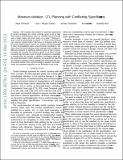| dc.contributor.author | Tumova, Jana | |
| dc.contributor.author | Reyes Castro, Luis Ignacio | |
| dc.contributor.author | Karaman, Sertac | |
| dc.contributor.author | Frazzoli, Emilio | |
| dc.contributor.author | Rus, Daniela L. | |
| dc.date.accessioned | 2013-10-29T13:08:28Z | |
| dc.date.available | 2013-10-29T13:08:28Z | |
| dc.date.issued | 2013-06 | |
| dc.identifier.isbn | 978-1-4799-0178-4 | |
| dc.identifier.uri | http://hdl.handle.net/1721.1/81823 | |
| dc.description | Original manuscript March 15, 2013 | en_US |
| dc.description.abstract | We consider the problem of automatic generation of control strategies for robotic vehicles given a set of high-level mission specifications, such as “Vehicle x must eventually visit a target region and then return to a base,” “Regions A and B must be periodically surveyed,” or “None of the vehicles can enter an unsafe region.” We focus on instances when all of the given specifications cannot be reached simultaneously due to their incompatibility and/or environmental constraints. We aim to find the least-violating control strategy while considering different priorities of satisfying different parts of the mission. Formally, we consider the missions given in the form of linear temporal logic formulas, each of which is assigned a reward that is earned when the formula is satisfied. Leveraging ideas from the automata-based model checking, we propose an algorithm for finding an optimal control strategy that maximizes the sum of rewards earned if this control strategy is applied. We demonstrate the proposed algorithm on an illustrative case study. | en_US |
| dc.description.sponsorship | United States. Air Force Office of Scientific Research (Michigan/AFRL Collaborative Center in Control Science Grant FA 8650-07-2-3744) | en_US |
| dc.description.sponsorship | National Science Foundation (U.S.) (Grant CNS-1016213) | en_US |
| dc.language.iso | en_US | |
| dc.publisher | Institute of Electrical and Electronics Engineers (IEEE) | en_US |
| dc.relation.isversionof | http://ieeexplore.ieee.org/stamp/stamp.jsp?tp=&arnumber=6579837 | en_US |
| dc.rights | Creative Commons Attribution-Noncommercial-Share Alike 3.0 | en_US |
| dc.rights.uri | http://creativecommons.org/licenses/by-nc-sa/3.0/ | en_US |
| dc.source | arXiv | en_US |
| dc.title | Minimum-violation LTL planning with conflicting specifications | en_US |
| dc.type | Article | en_US |
| dc.identifier.citation | Tumova, Jana et al. "Minimum-violation LTL planning with conflicting specifications." IEEE American Control Conference, 2013. | en_US |
| dc.contributor.department | Massachusetts Institute of Technology. Department of Aeronautics and Astronautics | en_US |
| dc.contributor.department | Massachusetts Institute of Technology. Department of Electrical Engineering and Computer Science | en_US |
| dc.contributor.mitauthor | Reyes Castro, Luis Ignacio | en_US |
| dc.contributor.mitauthor | Karaman, Sertac | en_US |
| dc.contributor.mitauthor | Frazzoli, Emilio | en_US |
| dc.contributor.mitauthor | Rus, Daniela L. | en_US |
| dc.relation.journal | Proceedings of the 2013 American Control Conference (ACC) | en_US |
| dc.eprint.version | Original manuscript | en_US |
| dc.type.uri | http://purl.org/eprint/type/ConferencePaper | en_US |
| eprint.status | http://purl.org/eprint/status/NonPeerReviewed | en_US |
| dspace.orderedauthors | Tumova, Jana; Reyes Castro, Luis Ignacio; Karaman, Sertac; Frazzoli, Emilio; Rus, Daniela L. | en_US |
| dc.identifier.orcid | https://orcid.org/0000-0001-5473-3566 | |
| dc.identifier.orcid | https://orcid.org/0000-0002-0505-1400 | |
| dc.identifier.orcid | https://orcid.org/0000-0002-2225-7275 | |
| mit.license | OPEN_ACCESS_POLICY | en_US |
| mit.metadata.status | Complete | |
